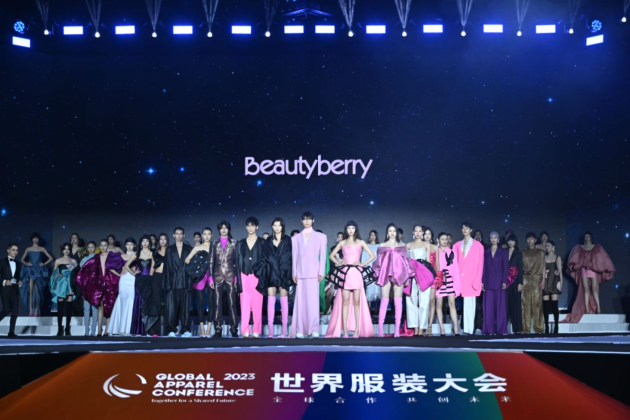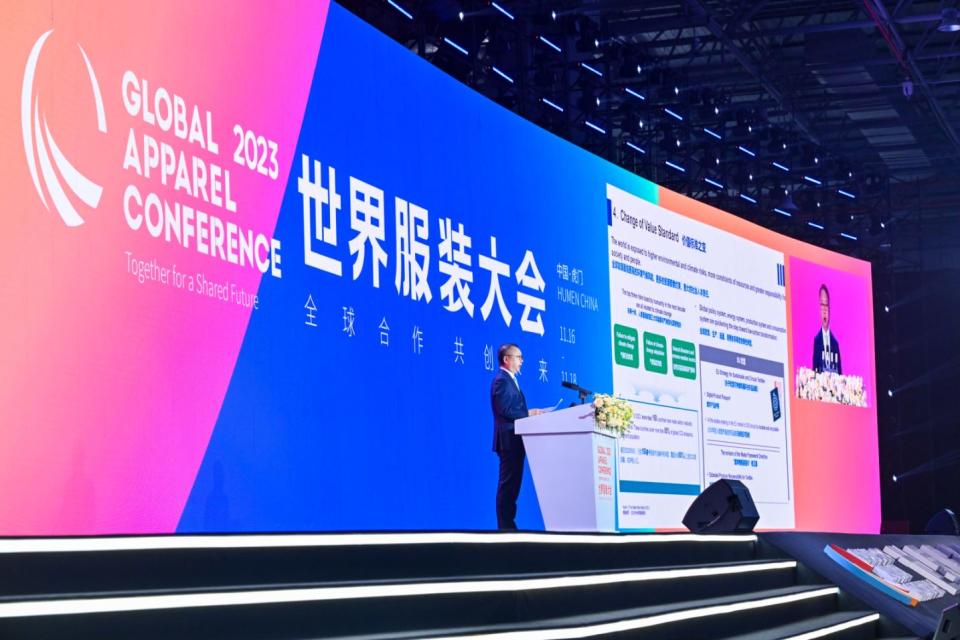WWD China Insight: Key Developments in the Apparel Sector in 2023

Last month 18 leaders from the global textile and apparel industries of nearly 20 countries gathered at the 2023 Global Apparel Conference, organized by the China National Textile and Apparel Council and the China National Garment Association, in Dongguan, Guangdong Province. Themed “Together for a Shared Future,” participants discussed topics ranging from digital management, supply chains, fashion trends, and cultural tradition to environmental protection and technology.
More from WWD
Walking Along Shanghai's Art Deco Lanes: A Guide for Flâneurs
Raxxy Lands at Modes, Nabs European Distribution Deal With N1
During the conference, Vice President Yang Zhaohua of the China Textile Industry Federation unveiled the “2023 China Textile and Apparel Brand Development Report,” summarizing the industry’s moves in terms of development patterns, innovative models, and key industrial actions.
The industry sees growth domestically
Despite challenging global market demands and the economic slowdown, China’s textile and apparel industry demonstrated resilience in the domestic market. From January to September, offline sales grew by 10.6 percent, and online sales increased by 9.6 percent. Chinese brands also raised their international profiles with brands like K-Boxing, Joeone, Ellassay, Bosideng and JNBY exhibiting on the global stage.
An increase in cross-border commerce and international investments
The rise of international e-commerce platforms has boosted the export of independent Chinese textile and apparel brands. Amazon and Shein have played key roles in advancing the industry. In terms of capital operations, Chinese companies have engaged in international mergers and acquisitions, including Biem.L.Fdlkk’s acquisition of Cerruti 1881 and Kent & Curwen, Anta Capital’s acquisition of the luxury home textile brand Frette, and Shein’s purchase of Missguided. Currently, Chinese companies’ cumulative overseas investment in the textile and apparel industry totals $11 billion, mainly concentrated in countries such as Vietnam, Cambodia, Myanmar, and Egypt.
Functional segmentation takes center stage
The sector is steadily transcending conventional distinctions between formal and casual wear, catering to an array of functional sectors like outdoor sports, yoga, and hiking and climbing. There also are encouraging developments in the home textiles market, where an emphasis is being placed on elevating quality and broadening applications. This notably involves addressing sleep quality concerns and enriching the overall joy of home life.
Pervasive application of industrial supplies and high-performance materials
Through the integration of high-performance materials and advanced processing technologies, industrial products have excelled in areas such as medical health, environmental protection, and transportation, as well as the energy sector. Brands like Anta Sports have expanded their portfolios, transcending sport accessories to encompass comprehensive runners’ services. Yuyue Home Textile made breakthroughs in the health domain, introducing innovations such as carbon nano-fiber threads and establishing rehabilitation hospitals. The application of carbon fiber in wind power and hydrogen storage is also a milestone for the industry.
Tech-infused cycle: smart production and living
The integration of digitization, intelligent manufacturing, private domain marketing, and the application of AI generated content have rendered textile enterprises adaptable to the demands of smart production and living. Leading groups like Hongxing Erke have implemented AIGC technology in product launches and community marketing, helping to reduce marketing costs. According to survey data, the market driven by virtual influencers surpassed $11 billion in 2023, with groups like Anta Sports and Semir utilizing digital influencers in live operations.
Sustainable development leads the future
The Chinese apparel industry has responded to the call for low-carbon green circular development, introducing measures such as the Climate Innovation 2030 Action and Carbon Neutrality Vision, laying the foundation for sustainable development.

A speaker at the conference.
Value Marketing in the Era of ESG
In the era of ESG, consumers are placing importance on the narrative behind each purchasing decision, intertwining identity and values. At the Global Apparel Conference, Johannes Neubacher, cofounder of WWD China, provided the following insights about ESG:
ESG values are reshaping corporate landscape
ESG has evolved into an indispensable yardstick for gauging corporate values and competitiveness. An analysis of major fashion trends that have been emerging over the last few years reveals that consumer behaviors, epitomized by trends like athleisure, gender fluidity, inclusive sizing, access to nature, and sustainable fashion, mirror the symbiotic values shared between brands and their audience.
Brand and consumer relationships are anchored in shared values
In the ESG era, businesses are challenged to forge connections with consumers through ESG, based on common values. Trust and loyalty from consumers hinge on this resonance, with shared values serving as the bedrock for cultivating enduring relationships. While trends may be ephemeral, values endure. Surveys indicate that more than 80 percent of consumers deem a company’s beliefs and values crucial, with 75 percent expressing a readiness to invest in products aligned with their values.
Crafting brand values requires a true commitment
In the pursuit of defining brand values, businesses must rise above mere rhetoric, focusing on genuine interactions that infuse values into products and tangible actions. Concurrently, companies should proactively engage in social responsibility, prioritize culture and craftsmanship, and make substantial contributions to the environment, education and society. Rewarding devoted users and involving them in the construction of brand values are indispensable facets of this authentic journey.
From cross-border commerce to smart production, the Chinese textile and apparel industry witnessed a transformative year in 2023. Resilience in the textile industry, cross-border success stories, functional fashion, and the rise of ESG values were among the highlights. As a new year looms, the industry’s commitment to innovation, sustainability, and authentic connections paves the way for a future where fashion transcends trends, embracing a narrative that resonates with both brands and consumers.
Editor’s Note: China Insight is a monthly feature from WWD’s sister publication WWD China focusing on key developments in that market.
Best of WWD

 Yahoo Lifestyle
Yahoo Lifestyle 
